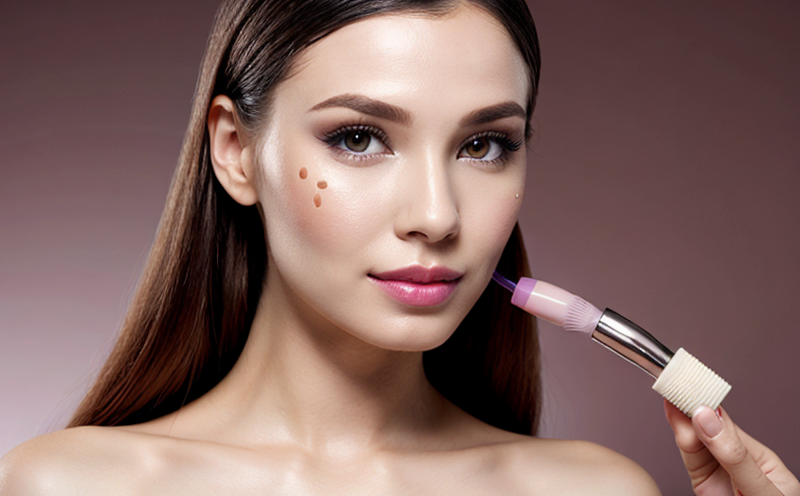In Vitro Safety Testing of Contact Lens Cosmetics
The safety evaluation of contact lens cosmetics is a critical aspect in ensuring consumer health and compliance with regulatory standards. In vitro testing provides a non-animal, humane alternative to traditional animal-based methods for assessing the potential irritancy, sensitization, and cytotoxicity of these products. This approach leverages cell cultures or tissue equivalents to simulate the behavior of the eye’s conjunctiva and cornea in response to cosmetic formulations.
The primary objective is to predict adverse effects that could occur during prolonged wear of contact lenses. By using in vitro models, we can efficiently screen for potential risks early in the development process, thereby reducing unnecessary animal testing while enhancing product safety.
For instance, the Cytosense™ system by MatTek Corporation employs 3D human skin equivalents to mimic ocular tissue. Such advanced technology allows us to observe cellular responses under various conditions, providing insights into how different ingredients interact with the eye’s delicate environment.
The testing process typically involves several steps: preparation of the test specimens (contact lens materials and formulations), application of the cosmetic product to the in vitro model, incubation periods for optimal interaction, and subsequent analysis using microscopy or other imaging techniques. The results help determine whether a product is safe enough for commercial use without causing significant harm.
One key advantage of this method lies in its ability to provide detailed information about specific components within cosmetic formulations that may contribute to adverse reactions. This level of granularity enables manufacturers to refine their products more effectively, addressing identified issues directly rather than relying solely on broad-spectrum testing methods.
In vitro safety testing also plays a crucial role in ensuring compliance with regulatory requirements worldwide. For example, the European Union Directive 79/831/EEC mandates that all new cosmetics sold within EU member states undergo stringent safety evaluations before reaching market shelves. Similarly, U.S. Food and Drug Administration (FDA) guidelines emphasize the importance of robust preclinical testing protocols for any product intended for direct application to mucous membranes.
The methodology employed ensures consistency across various types of contact lens cosmetics, including daily wear lenses, extended-wear models, and specialty lenses designed for specific ocular conditions. Each type presents unique challenges regarding material composition, chemical stability, and compatibility with human tissues. Therefore, tailoring the in vitro tests to address these factors is essential.
Moreover, this testing approach supports sustainable practices by minimizing reliance on live animals while delivering reliable data necessary for regulatory approval processes. As consumer awareness around ethical production methods grows, companies adopting such innovative technologies stand to gain competitive advantages in terms of reputation and market share.
Applied Standards
| Standard | Description |
|---|---|
| ISO 10993-11:2018 | Biocompatibility Testing of Medical Devices - Part 11: Skin Irritation and Sensitization Tests Using In Vitro Methods. |
| ASTM F2147-15 | Standard Practice for Conducting In Vitro Cytotoxicity Test on Medical Devices. |
| IOMC (International Ocular Manufacturing Council) Guidelines | Recommendations for the Use of In Vitro Methods in Contact Lens Cosmetics Testing. |
Why Choose This Test
In vitro safety testing offers numerous benefits over traditional animal-based methods when evaluating contact lens cosmetics. Firstly, it significantly reduces ethical concerns associated with animal experimentation by offering a more humane alternative. Secondly, this approach enhances accuracy and reproducibility since the same standardized conditions can be consistently applied to multiple samples.
Additionally, in vitro tests allow for faster turnaround times compared to live animal studies, enabling quicker product development cycles and timely market launches. Furthermore, they provide deeper insights into individual components' impacts on ocular health, facilitating targeted improvements that address specific issues more effectively than generalized approaches.
Compliance with international standards ensures consistent quality across diverse markets, reducing potential discrepancies between regulatory requirements in different regions. Lastly, the availability of advanced technologies like Cytosense™ supports continuous innovation by allowing researchers to explore new methodologies and improve existing ones.
Use Cases and Application Examples
- Evaluation of preservative efficacy against microorganisms commonly found in contact lens solutions.
- Determining the optimal pH range for maximum comfort and minimal irritation during prolonged wear.
- Assessing the cytotoxicity profile of different lens coatings designed to enhance oxygen permeability or reduce protein buildup.
- Identifying potential allergens present in the formulation that might trigger adverse reactions upon extended contact with ocular tissues.
- Evaluating antioxidant properties intended to protect against oxidative stress induced by environmental factors such as UV radiation and atmospheric pollutants.





